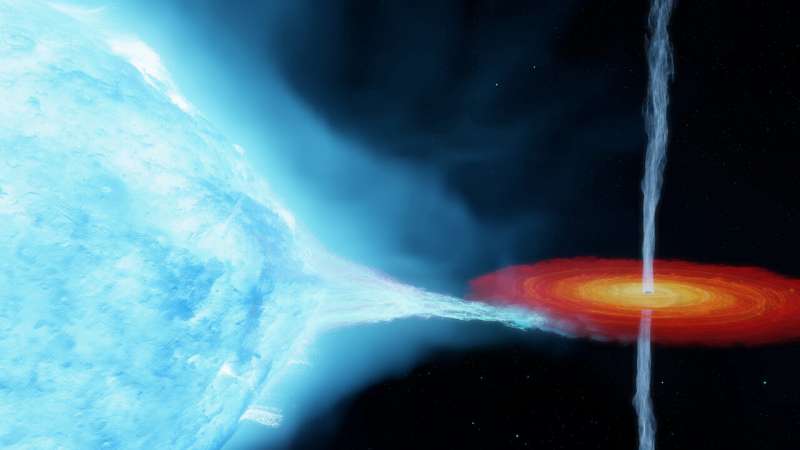New observations of the first black hole ever detected have led astronomers to question what they know about the Universe’s most mysterious objects. Published in the journal Science, the research shows the system known as Cygnus X-1 contains the most massive stellar-mass black hole ever detected without the use of gravitational waves.
Cygnus X-1 is one of the closest black holes to Earth. It was discovered in 1964 when a pair of Geiger counters were carried onboard a sub-orbital rocket launched from New Mexico. The object was the focus of a famous scientific wager between physicists Stephen Hawking and Kip Thorne, with Hawking betting in 1974 that it was not a black hole. Hawking conceded the bet in 1990.

In this latest work, an international team of astronomers used the Very Long Baseline Array — a continent-sized radio telescope made up of 10 dishes spread across the United States — together with a clever technique to measure distances in space. Lead researcher Professor James Miller-Jones from Curtin University and the International Centre for Radio Astronomy Research (ICRAR), said:
“If we can view the same object from different locations, we can calculate its distance away from us by measuring how far the object appears to move relative to the background. If you hold your finger out in front of your eyes and view it with one eye at a time, you’ll notice your finger appears to jump from one spot to another. It’s exactly the same principle.
“Over six days we observed a full orbit of the black hole and used observations taken of the same system with the same telescope array in 2011. This method and our new measurements show the system is further away than previously thought, with a black hole that’s significantly more massive.”

This black hole is massive
Co-author Professor Ilya Mandel from Monash University and the ARC Centre of Excellence in Gravitational Wave Discovery (OzGrav) said the black hole is so massive it’s actually challenging how astronomers thought they formed:
“Stars lose mass to their surrounding environment through stellar winds that blow away from their surface. But to make a black hole this heavy, we need to dial down the amount of mass that bright stars lose during their lifetimes. The black hole in the Cygnus X-1 system began life as a star approximately 60 times the mass of the Sun and collapsed tens of thousands of years ago.
“Incredibly, it’s orbiting its companion star — a supergiant — every five and a half days at just one-fifth of the distance between the Earth and the Sun. These new observations tell us the black hole is more than 20 times the mass of our Sun — a 50 per cent increase on previous estimates.”
Xueshan Zhao, a co-author on the paper and a Ph.D. candidate studying at the National Astronomical Observatories — part of the Chinese Academy of Sciences (NAOC) in Beijing, said:
“Using the updated measurements for the black hole’s mass and its distance away from Earth, I was able to confirm that Cygnus X-1 is spinning incredibly quickly — very close to the speed of light and faster than any other black hole found to date.
“I’m at the beginning of my research career, so being a part of an international team and helping to refine the properties of the first black hole ever discovered has been a great opportunity.”
Provided by: International Centre for Radio Astronomy Research [Note: Materials may be edited for content and length.]
Follow us on Twitter, Facebook, or Pinterest

